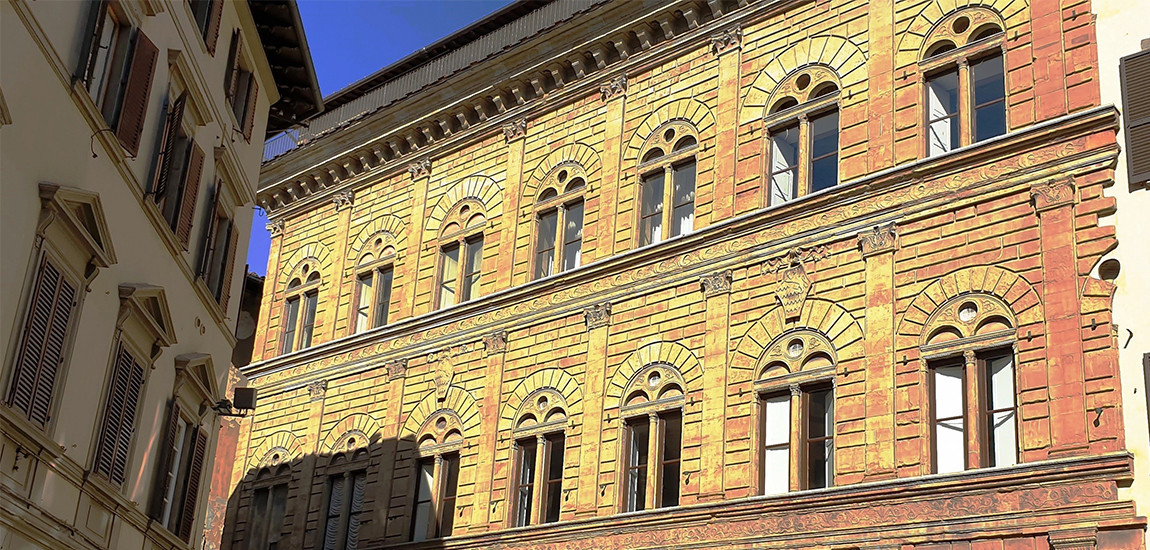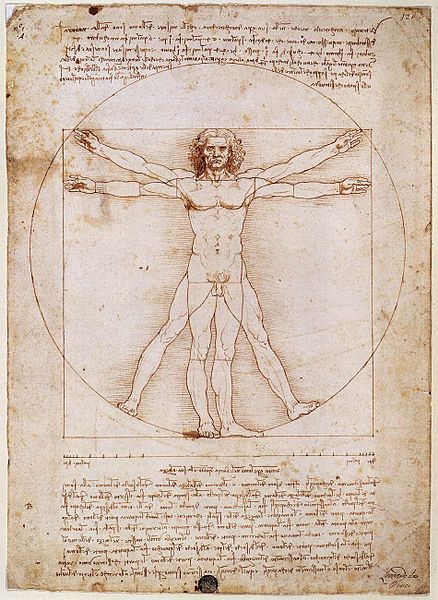
Beyond the Renaissance in Florence - The Golden Ratio in art and at Palazzo Rucellai
This time the title "Beyond
the Renaissance" should be interpreted as "Renaissance beyond itself", that is, at the top of its
idea of the world and of the rediscovery of classical culture.
The facade of
Palazzo Rucellai, designed by Leon Battista Alberti and completed in 1465, is
celebrated as one of th art works symbolic of the spirit of the time. Alberti
designed it as an exemplary demonstration of his architectural principles,
described in his book De Re Aedificatoria
(On Architecture, 1452), where he explains that beauty does not derive from splendor or decorative magnificence, but from harmony and proportions.
The façade, in rustication of pietraforte, is
structured on three floors with a regular grid of rectangles, defined horizontally by stringcourses and by a street bench at the base, and vertically by
pilasters with capitals. These rectangles enclose mullioned windows on the
first and second floors and small windows and doors on the ground floor. There
are many elements taken from classical architecture, but here we see in
particular only one, though sensational: all the rectangles that make up the grid
are built on the basis of the Golden Ratio.
What is the Golden Ratio? Without going into the mathematical
definition, in geometry it is the
particular proportion between two unequal segments that can constitute elements
of rectangles, triangles and pentagons. Dividing the measure of the large
segment by the measure of the smaller one, we find the irrational
number (that is, with infinite decimals) 1.6180339887… The rectangle, which
basis is the sum of two segments in this relationship, was already considered in the Greco-Roman world to be the "natural" canon of beauty and
harmony. The Parthenon in Athens is entirely structured on these golden rectangles, the same ones that make up the facade of Palazzo
Rucellai.
The Golden Ratio has a long history. Its definition dates
back to the 6th century BC. and it is attributed to Pythagoras and his disciples
who gave it magical and astrological meanings. The Greeks were convinced that art works created following these proportions, would have a strong sense of order, harmony
and symmetry. A sense of completeness and perfection in which they glimpsed a
divine plan, a superior scheme used by gods to create nature, man and the universe.
Plato also gave it a mystical meaning and stated: “God always geometrizes”. Even the human body, to be "beautiful" had to be perfectly
symmetrical and with golden
proportions.
Renaissance artists were fascinated by this harmony found in the ancient art. The manual "De Architectura" by Vitruvius - a Roman architect of the first
century BC who had been war machines superintendent in Caesar’s army and also Augustus’
court architect - was translated by the humanist Poggio Bracciolini in 1414,
read and loved by Lorenzo Ghiberti, Leon Battista Alberti, Raphael, Paolo
Giovio and specially Leonardo da Vinci.
Vitruvius had studied the "mathematical" basis of the beauty of the human body,
establishing that the height must be equal to the arm span and that
the figure can be inscribed in a circle. On this basis he then calculated the perfect proportional measurements
of all parts of the body. Inspired by Vitruvius, Leonardo in 1490 drew the famous Vitruvian Man, the ideal man, that for centuries was the basis of the studies of anatomical
aesthetics. The figure is inserted in a circle (the sky) and in a square (the
earth). The radius of the circle and the side of the square are proportioned
according to the Golden Ratio. Leonardo also recalculated all the proportions
of the parts of the "perfect"
human body made by Vitruvius, confirming them, apart from the feet, which
according to him should have been shorter: one seventh of the height, instead
of the one sixth calculated by Vitruvius.
Leonardo's drawing has become one of the symbols of Humanism
and Renaissance. The circle and the square are perfect geometric figures. The man,
proportionate to the Golden Ratio, is perfect because he is the center
of the universe and, he is - as the saying went - "the
architect of his own fate", he can manage his own life, he can choose
his own destiny. The opposite of the medieval man, crushed by divinity.

Leonardo da Vinci's Vitruvian Man.
Leonardo also used the Golden Ratio in painting, like in the Last
Supper and in the face of the Mona Lisa. Many
other artists have used it, including Le Corbusier, one of the
most important architects of the twentieth century. The Swiss architect, theorized that, since the Golden Section
is the basis of the proportions of the human body, all the
living and working spaces in which man moves must be structured on these
measures. Leon Battista Alberti hadn't gone that far.
Even Walt Disney's Donald Duck had something to do with the Golden Ratio. In the 1959's cartoon Donald in Mathmagic Land, used as an educational film in American schools, Donald Duck enters the Wonderland of Mathematics. There he meets Pythagoras who is playing in a jazz jam session with his disciples. The Greek philosopher reveals that the world is based on mathematics and the Golden Ratio is everywhere: in Cheops’ Pyramid, in Leonardo's Mona Lisa, in Alexander of Antioch's Venus de Milo, in Phidias’ Parthenon in Athens, in Le Corbusier's UN Building in New York, in the human body, in music, in the structure of flowers, marine animals, galaxies. In short, in every form of the universe. Donald, overwhelmed by this discovery, finally becomes convinced that the future is in mathematics and geometry.
Fun fact: the two sides of our credit cards, debit cards and now every magnetic card are proportionate to the Golden Ratio. If you divide the larger side with the smaller side, you will always get 1.6180339887…!
Cover Photo: The façade of palazzo Rucellai.



